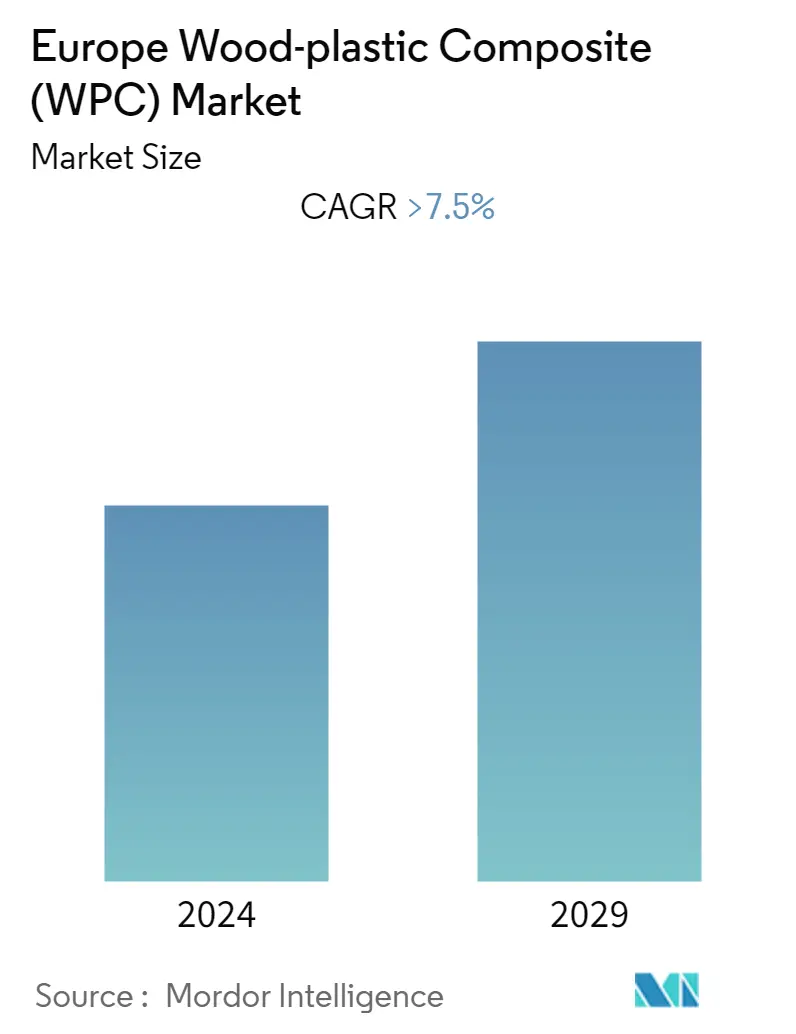Market Size of Europe Wood-plastic Composite (WPC) Industry

| Study Period | 2019 - 2029 |
| Base Year For Estimation | 2023 |
| Forecast Data Period | 2024 - 2029 |
| Historical Data Period | 2019 - 2022 |
| CAGR | > 7.50 % |
| Market Concentration | Low |
Major Players_Market_-_Market_Players.webp)
*Disclaimer: Major Players sorted in no particular order |
Europe Wood Plastic Composite (WPC) Market Analysis
The Europe wood-plastic composite (WPC) market is expected to register a CAGR of over 7.5%, during the forecast period.
The market was negatively impacted by COVID-19 in 2020. During the pandemic, construction activities were stopped temporarily due to lockdowns. According to Eurostat, construction decreased by 28.4% in the Euro areas (EU-19 member countries) and 24% in the European Union (EU-27 member countries) in April 2020 compared to April 2019. However, the sector has been recovering well since restrictions were lifted. Construction activities in Europe have increased as the local government and European Union have increased the fund size due to rising demand for residential and commercial spaces. The demand for automobiles, which consume wood-plastic composite (WPC), has also increased, thus stimulating the market demand.
- The rising demand for wood-plastic composites in domestic construction, owing to their sustainable characteristics and increasing refurbishment activities in the region, is expected to drive the market's growth.
- However, the high cost of wood-plastic composites and performance-related issues in certain conditions can hinder the growth of the market.
- Innovations in the biological durability of WPCs against algae, mold, fungi, and termites are likely to create opportunities for the market in the coming years.
- Germany accounts for the major share of the market, and it is expected to dominate the market during the forecast period.
Europe Wood Plastic Composite (WPC) Industry Segmentation
Wood-plastic composite (WPC) is a composite material made of wood fibers, such as sawdust, pulp, peanut hulls, bamboo, and plastic materials, including polypropylene (PP) and polyethylene (PE). The WPC granulates can be further processed through extrusion, injection molding, blow molding, compression molding, and other methods to produce different products for various end-user industries, including construction and automotive. The European wood plastic composite (WPC) market is segmented by application and geography. By application, the market is segmented into decking, auto-interior parts, siding and fencing, technical applications, furniture, and consumer goods. The report also covers the market size and forecasts for the wood-plastic composite market in 8 countries across Europe. For each segment, the market sizing and forecasts have been done based on volume (kilo tons).
| Application | |
| Decking | |
| Auto-interior Parts | |
| Siding and Fencing | |
| Technical Applications | |
| Furniture | |
| Consumer Goods |
| Geography | |
| Germany | |
| United Kingdom | |
| France | |
| Belgium | |
| Finland | |
| Norway | |
| Denmark | |
| Sweden | |
| Rest of Europe |
Europe Wood-plastic Composite (WPC) Market Size Summary
The European wood-plastic composite (WPC) market is poised for significant growth, driven by increasing demand in the construction and automotive sectors. The market experienced a downturn due to the COVID-19 pandemic, which temporarily halted construction activities across Europe. However, recovery has been robust, supported by government investments in residential and commercial infrastructure. The sustainable properties of WPCs are particularly appealing in domestic construction, where refurbishment activities are on the rise. Despite challenges such as high costs and performance issues in certain conditions, innovations in biological durability against environmental factors present new opportunities for market expansion. Germany stands out as a key player, dominating the market due to its strong manufacturing and consumption capabilities, particularly in construction and automotive applications.
The WPC market in Europe is characterized by a fragmented landscape with several key players, including NOVO-TECH GmbH & Co. KG, Beologic NV, and JELU-WERK Josef Ehrler GmbH & Co. KG. The market's growth is further bolstered by strategic acquisitions and certifications that enhance product value and sustainability. For instance, the acquisition of Naftex by Biofibre and Novowood's ReMade in Italy certification highlight the industry's focus on innovation and circular economy principles. The demand for WPCs is also supported by the burgeoning furniture industry in Germany, which is the largest in Europe, and the increasing production of electric vehicles, which necessitate the use of WPCs in auto-interior parts. These factors collectively contribute to the positive outlook for the European WPC market over the forecast period.
Europe Wood-plastic Composite (WPC) Market Size - Table of Contents
-
1. MARKET DYNAMICS
-
1.1 Drivers
-
1.1.1 Sustainable Characteristics of Wood-plastic Composites
-
1.1.2 Growing Demand from Construction Industry
-
-
1.2 Restraints
-
1.2.1 High Cost of Wood-plastic Composites
-
1.2.2 Other Restraints
-
-
1.3 Industry Value Chain Analysis
-
1.4 Porter's Five Forces Analysis
-
1.4.1 Bargaining Power of Suppliers
-
1.4.2 Bargaining Power of Buyers
-
1.4.3 Threat of New Entrants
-
1.4.4 Threat of Substitute Products and Services
-
1.4.5 Degree of Competition
-
-
-
2. MARKET SEGMENTATION (Market Size in Volume)
-
2.1 Application
-
2.1.1 Decking
-
2.1.2 Auto-interior Parts
-
2.1.3 Siding and Fencing
-
2.1.4 Technical Applications
-
2.1.5 Furniture
-
2.1.6 Consumer Goods
-
-
2.2 Geography
-
2.2.1 Germany
-
2.2.2 United Kingdom
-
2.2.3 France
-
2.2.4 Belgium
-
2.2.5 Finland
-
2.2.6 Norway
-
2.2.7 Denmark
-
2.2.8 Sweden
-
2.2.9 Rest of Europe
-
-
Europe Wood-plastic Composite (WPC) Market Size FAQs
What is the current Europe Wood-plastic Composite (WPC) Market size?
The Europe Wood-plastic Composite (WPC) Market is projected to register a CAGR of greater than 7.5% during the forecast period (2024-2029)
Who are the key players in Europe Wood-plastic Composite (WPC) Market?
NOVO-TECH GmbH & Co. KG, Beologic NV, JELU-WERK Josef Ehrler GmbH & Co. KG, Tecnaro GmbH and Kosche Holzwerkstoffe GmbH & Co. KG are the major companies operating in the Europe Wood-plastic Composite (WPC) Market.

